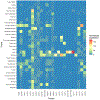Important roles of transporters in the pharmacokinetics of anti-viral nucleoside/nucleotide analogs
- PMID: 35975669
- PMCID: PMC9506706
- DOI: 10.1080/17425255.2022.2112175
Important roles of transporters in the pharmacokinetics of anti-viral nucleoside/nucleotide analogs
Abstract
Introduction: Nucleoside analogs are an important class of antiviral agents. Due to the high hydrophilicity and limited membrane permeability of antiviral nucleoside/nucleotide analogs (AVNAs), transporters play critical roles in AVNA pharmacokinetics. Understanding the properties of these transporters is important to accelerate translational research for AVNAs.
Areas covered: The roles of key transporters in the pharmacokinetics of 25 approved AVNAs were reviewed. Clinically relevant information that can be explained by the modulation of transporter functions is also highlighted.
Expert opinion: Although the roles of transporters in the intestinal absorption and renal excretion of AVNAs have been well identified, more research is warranted to understand their roles in the distribution of AVNAs, especially to immune privileged compartments where treatment of viral infection is challenging. P-gp, MRP4, BCRP, and nucleoside transporters have shown extensive impacts in the disposition of AVNAs. It is highly recommended that the role of transporters should be investigated during the development of novel AVNAs. Clinically, co-administered inhibitors and genetic polymorphism of transporters are the two most frequently reported factors altering AVNA pharmacokinetics. Physiopathology conditions also regulate transporter activities, while their effects on pharmacokinetics need further exploration. Pharmacokinetic models could be useful for elucidating these complicated factors in clinical settings.
Keywords: Antiviral agents; drug transporter; drug–drug interaction; genetic polymorphism; nucleoside/nucleotide analogs; pharmacokinetics.
Figures



Similar articles
-
Transport of nucleoside analogs across the plasma membrane: a clue to understanding drug-induced cytotoxicity.Curr Drug Metab. 2009 May;10(4):347-58. doi: 10.2174/138920009788499030. Curr Drug Metab. 2009. PMID: 19519343 Review.
-
The role of transporters in the toxicity of nucleoside and nucleotide analogs.Expert Opin Drug Metab Toxicol. 2012 Jun;8(6):665-76. doi: 10.1517/17425255.2012.680885. Epub 2012 Apr 18. Expert Opin Drug Metab Toxicol. 2012. PMID: 22509856 Free PMC article. Review.
-
Biochemical interaction of anti-HCV telaprevir with the ABC transporters P-glycoprotein and breast cancer resistance protein.BMC Res Notes. 2013 Nov 6;6:445. doi: 10.1186/1756-0500-6-445. BMC Res Notes. 2013. PMID: 24196382 Free PMC article.
-
Multiple human isoforms of drug transporters contribute to the hepatic and renal transport of olmesartan, a selective antagonist of the angiotensin II AT1-receptor.Drug Metab Dispos. 2007 Dec;35(12):2166-76. doi: 10.1124/dmd.107.017459. Epub 2007 Sep 6. Drug Metab Dispos. 2007. PMID: 17823233
-
ABC transporters and their role in nucleoside and nucleotide drug resistance.Biochem Pharmacol. 2012 Apr 15;83(8):1073-83. doi: 10.1016/j.bcp.2011.12.042. Epub 2012 Jan 20. Biochem Pharmacol. 2012. PMID: 22285911 Free PMC article. Review.
Cited by
-
Viral dissemination and immune activation modulate antiretroviral drug levels in lymph nodes of SIV-infected rhesus macaques.Front Immunol. 2023 Sep 18;14:1213455. doi: 10.3389/fimmu.2023.1213455. eCollection 2023. Front Immunol. 2023. PMID: 37790938 Free PMC article.
-
Construction and validation of a cell based reporter assay for identifying inhibitors of SARS coronavirus 2 RNA dependent RNA polymerase activity.Sci Rep. 2025 May 26;15(1):18443. doi: 10.1038/s41598-025-03813-y. Sci Rep. 2025. PMID: 40419748 Free PMC article.
-
Composing On-Program Triggers and On-Demand Stimuli into Biosensor Drug Carriers in Drug Delivery Systems for Programmable Arthritis Therapy.Pharmaceuticals (Basel). 2022 Oct 27;15(11):1330. doi: 10.3390/ph15111330. Pharmaceuticals (Basel). 2022. PMID: 36355502 Free PMC article. Review.
-
Pharmacogenetic determinants of tenofovir diphosphate and lamivudine triphosphate concentrations in people with HIV/HBV coinfection.Antimicrob Agents Chemother. 2024 Sep 4;68(9):e0054924. doi: 10.1128/aac.00549-24. Epub 2024 Jul 30. Antimicrob Agents Chemother. 2024. PMID: 39078131 Free PMC article.
-
An Exploratory Pharmacogenetic Pilot Study of Two Reverse Transcriptase Inhibitors, Tenofovir Alafenamide Fumarate and Tenofovir Disoproxil Fumarate.Drugs R D. 2025 Jun;25(2):153-160. doi: 10.1007/s40268-025-00509-6. Epub 2025 May 25. Drugs R D. 2025. PMID: 40413716 Free PMC article.
References
-
- Vardanyan RS, Hruby VJ. Chapter 34 - Antiviral Drugs. In: Vardanyan R, Hruby V, editors. Synthesis of Best-Seller Drugs. Boston: Academic Press; 2016. p. 687–736.
-
- Jordheim LP, Durantel D, Zoulim F, et al. Advances in the development of nucleoside and nucleotide analogues for cancer and viral diseases. Nat Rev Drug Discov. 2013. Jun;12(6):447–64. - PubMed
-
* A review highlights the different approaches used in the development of these drugs.
-
- Parkinson FE, Damaraju VL, Graham K, et al. Molecular biology of nucleoside transporters and their distributions and functions in the brain. Curr Top Med Chem. 2011;11(8):948–72. - PubMed
MeSH terms
Substances
Grants and funding
LinkOut - more resources
Full Text Sources
Miscellaneous
